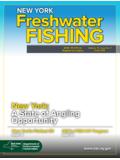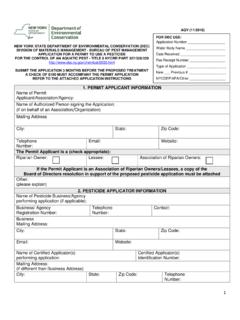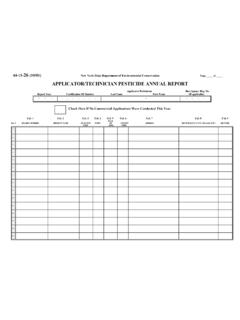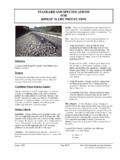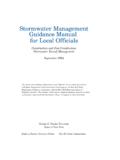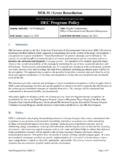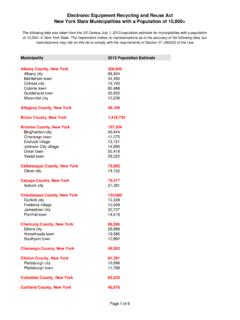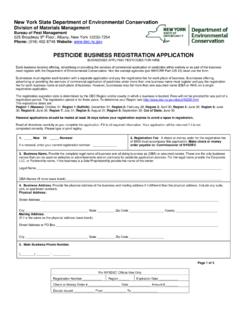Transcription of An Introduction to Responsible Trapping - New …
1 Trapping Furbearers An Introduction to Responsible Trapping Student Manual i Code of Trapping Ethics 1. Know and obey Trapping laws and assist in their enforcement by reporting violations. 2. Improve your knowledge of furbearers, their ecology and management, and improved Trapping and fur handling methods. 3. Respect landowners rights and always obtain permission before Trapping on private lands. 4. Respect and conserve public lands and the natural resources found on them. 5. Be aware of other people using the outdoors and avoid interference with their activities. 6. Be aware of free ranging domestic animals and avoid Trapping where there is a high risk of catching them. 7. Know and use selective and humane Trapping sets with appropriate trap types and sizes. 8. Don t set more traps than YOU can effectively handle. 9. Cover all foothold traps set on land. 10. When Trapping muskrat, always use body gripping traps, guarded foothold traps, or submersion sets.
2 11. Use body gripping traps or submersion sets with sliding locks for all beaver and otter sets. 12. Anchor traps securely enough to hold the largest potential catch. 13. Check all traps daily and as early in the day as possible. 14. Dispose of animal carcasses properly. 15. Support Trapping , trapper training, and furbearer management and research. 16. Report diseased animals. 17. Make an effort to trap any areas where furbearer populations are overabundant or are creating a nuisance. 18. Know and use proper releasing and killing methods. ii Trapping Furbearers An Introduction to Responsible Trapping Acknowledgements A long list of distinguished individuals had a hand in the development of this manual over time. It is based in part on, Trapping Furbearers Managing and Using a Renewable Natural Resource , by Dr. Ronald Howard and Dr. John Kelley, published by 4 H/Cooperative Extension at Cornell University. Former and current Department of Environmental Conservation (DEC) staff who participated in the manual s many editions include Louis Berchielli, Gary Parsons, Mark Brown, Wayne Jones, Paul Bishop, Benjamin Tullar, Robert Henke, David Scudder, Gordon Batcheller, Scott Smith, Melissa Neely, and Ken Baginski.
3 Critical review of the text was provided by trappers Pete Smith, Tom Hayes, Angie Leubner, Pete Rickard, Gordon Berndt, Tom Fisher, and Ray Schedivy (1st edition), Al West and Jerry Leggieri (2nd edition), and John Rockwood, Angie Berchielli, and Jerry Leggieri (3rd edition). Fourth edition, printed in 2016. DEC biologist Andy MacDuff performed editorial duties with input from trappers Lou and Angie Berchielli. Materials used from other sources for this manual include: Association of Fish & Wildlife Agencies logos on page 33 and material in Chapters 5, 7, and 8 and Appendices 1, 2, and 5 (with changes) Silvertip Productions Images on pages 5, 6, 15, 16, 17, 80, 81 (bottom), 100, and 101 Ohio Division of Wildlife Images on pages 24 (top), 26 (bottom), 30, 37, 39, 77, 78, 81 (top), and 86 through 93 Joe Goodman Images on pages 26(top and middle), 29 (bottom), 75 (all but weasel box), 104, and 105. Animal artwork was provided by Wayne Trimm and all other drawings by Michael Stickney.
4 Funded in part by Federal Aid in Wildlife Restoration Act, project W 125 S, a hunter education project supported by federal excise taxes on hunting equipment. Copyright 1997, 2006, 2011, 2016. All rights reserved. Material may not be reproduced in any manner without express written permission from the Department of Environmental Conservation. NYSDEC Sportsman Education, 625 Broadway, Albany, NY 12233 4800iii Trapping Furbearers An Introduction to Responsible Trapping Table of Contents Chapter 1 Introduction .. 1 Chapter 2 History of Trapping .. 3 Chapter 3 Furbearer Management .. 5 Chapter 4 Trapping Laws, Regulations, and Ethics .. 9 Chapter 5 Trapping Safety and Wildlife Diseases .. 15 Chapter 6 Equipment and Preparation .. 23 Chapter 7 Best Management Practices .. 33 Chapter 8 Selective Trapping Techniques .. 37 Chapter 9 Natural History of New York Furbearers .. 41 Chapter 10 Common Water Sets .. 67 Chapter 11 Land Sets.
5 74 Chapter 12 Running a Trapline .. 80 Chapter 13 Fur Handling Equipment, Techniques, and Marketing .. 86 Appendix 1 Traps, Sets, & Attractors .. 98 Appendix 2 Tracks of New York Furbearers .. 100 Appendix 3 Scats of New York Furbearers .. 102 Appendix 4 Regulations for Body Grip Traps Set on Land .. 104 Appendix 5 Pelt Preparation .. 106 iv 1 Chapter 1 Introduction You and Trapper Education Trapping is enjoyable and it provides a variety of benefits to those with the knowledge and ability to do it well. But, if Trapping is not done right, it can cause bad feelings towards trappers and Trapping . Therefore, Trapping is a serious business. The future of Trapping depends on the way you as a trapper perform. Successful completion of a trapper education course is required of all first time trappers in New York State. This requirement started in 1980 to increase awareness of the trapper s responsibilities and to introduce beginning trappers to acceptable Trapping methods, ethics and responsibilities, laws and regulations, natural history, and basic wildlife management principles.
6 All of these things provide a good start for new trappers. Trapping skill, however, must be developed through experience after the course. The things you learn in this course will help make Trapping more enjoyable and help make you more successful. Through this course, you can learn more about the tradition and adventure of Trapping , increase your environmental awareness, gain new outdoor skills, and maybe even make some money. In addition, there is the opportunity for personal development through hard work, careful study, and a better understanding of nature and wildlife. It is hoped the course will also encourage beginning trappers to learn more about Trapping from personal experience and the experience of others. You can learn even more about Trapping from information you can get from your instructor, your library, the internet, and from local, state, and national trapper organizations. 2 3 Chapter 2 History of Trapping Since prehistoric times, human beings have used traps of various kinds to capture animals for food, clothing, or population control.
7 The earliest forms of traps were probably pits, deadfalls or snares. Of these three trap types, only snares, now called cable restraints or cable traps, are still commonly used today. When Europeans first came to North America, they depended on the plentiful furbearer resources. The demand for fur in Europe, especially beaver, created a large and thriving fur trade in North America from which Native Americans and some of the new immigrants derived a portion of their livelihood. It was the lure of richer hunting and Trapping territories, particularly for beaver, more than the lure of rich soil or even gold that prompted westward exploration and settlement. Along the paths opened by these pioneering trappers, first commerce and then agriculture spread across the nation. During the 1800s, groups of trappers and explorers known as mountain men, many armed with Newhouse traps, journeyed up the Missouri River to explore the beaver meadows of the Rocky Mountains from Canada to New Mexico.
8 The golden age of fur saw native people both befriended and exploited, trappers survived hardships to make or to lose fortunes, and many lives lost all for the sake of fur. New York State has a rich history in the fur trade. In the mid 1600s, the area now occupied by Albany, our state capital, was known as Beverwyck in recognition of the volume of fur that flowed through the region. Even today, the official seal of Albany depicts a beaver cutting down a tree, a clear connection to the significant role Trapping played in the exploration and development of the Empire State. Also, the Newhouse traps used by the mountain men of the 1800s were manufactured in the Oneida, area. Thanks to sound wildlife management, large populations of furbearers still exist, and many people depend on Trapping them to supplement their income. Well regulated hunting and Trapping provide pleasurable and profitable means of using a renewable natural resource without depleting animal populations or reducing opportunities for others to enjoy them.
9 4 5 Chapter 3 Furbearer Management The Furbearer Resource New York State is fortunate to have an abundance of furbearers, including muskrat, mink, beaver, otter, opossum, skunk, raccoon, gray fox, red fox, coyote, weasel, fisher, bobcat and marten. These animals have a number of effects upon the environment, economics, and the quality of human life in addition to their fur value. With the exception of beaver and muskrat, most furbearers are predators which are important to maintaining ecological balance in natural systems. Any discussion of the value of furbearers must consider both their beneficial and harmful effects. Beaver may flood valuable agricultural lands, homes, roadways, woodlands, and in some instances, have detrimental impacts to trout populations. However, their ponds create valuable habitat for animals such as mink, muskrat, and otter and many species of birds. Muskrat eat aquatic vegetation, often opening up portions of marshes creating habitat for fish and wildlife.
10 However, muskrats can be extremely destructive to the banks and dikes of man made ponds and lakes. Predatory furbearers, which must kill other animals to eat, may prey on domestic stock, game animals or other valued or rare wildlife. In some areas, coyotes may cause losses of free ranging stock such as sheep or chickens. Coyotes can play a positive role by controlling mice and other rodents. The corn and songbird depredations of raccoon and skunk must be balanced against their controlling effects on insects and rodents. Another negative concern is that furbearers sometimes carry diseases like rabies and tularemia and parasites like mange mites and ticks. These are just a few of the tangible positive and negative values of the furbearer resource. The pleasure of seeing and studying these animals is probably the greatest of the intangible values. When both positive and negative aspects are considered, the importance of scientifically based wildlife management becomes apparent.
